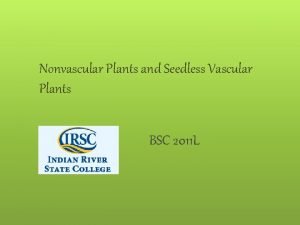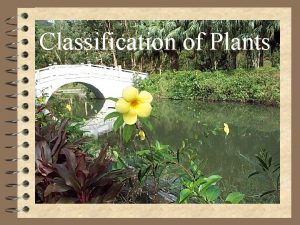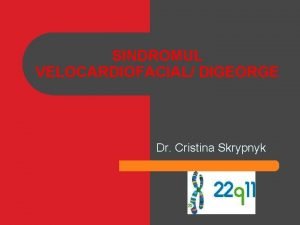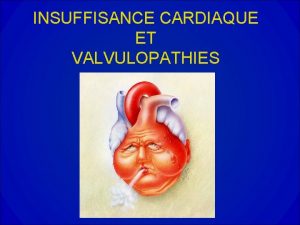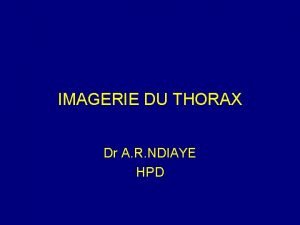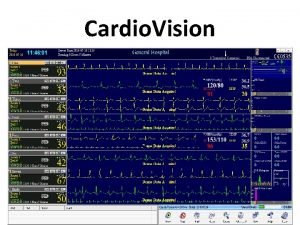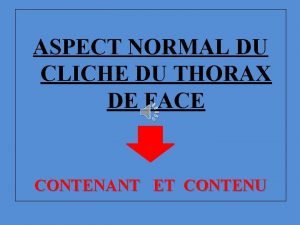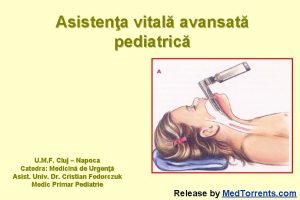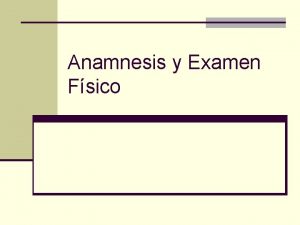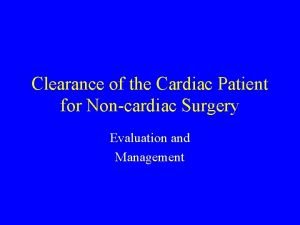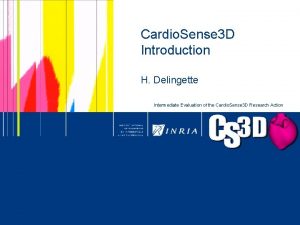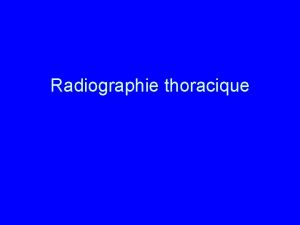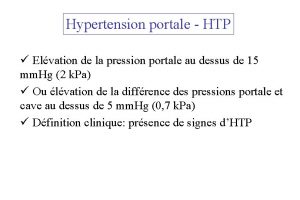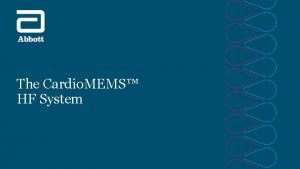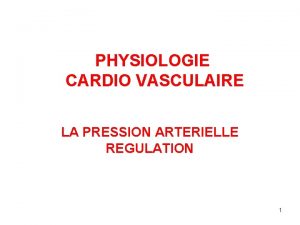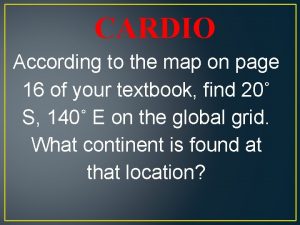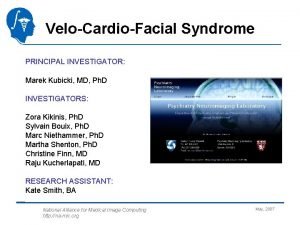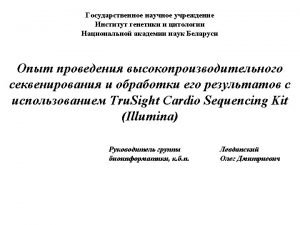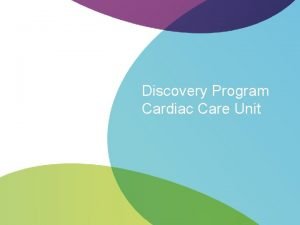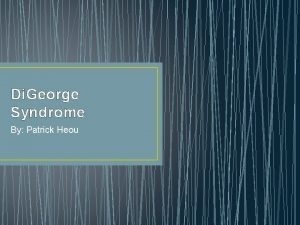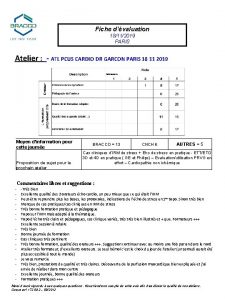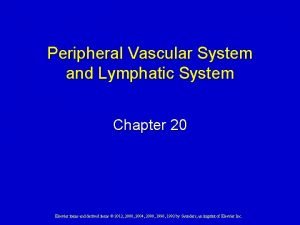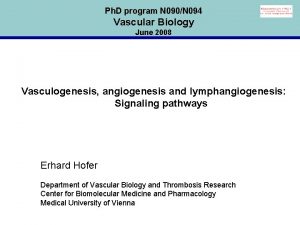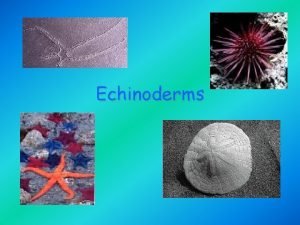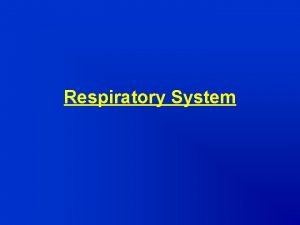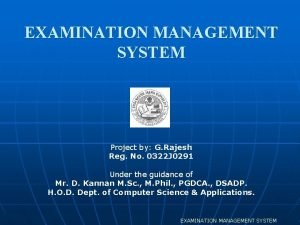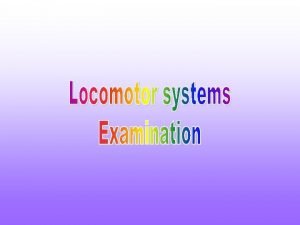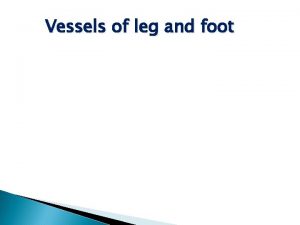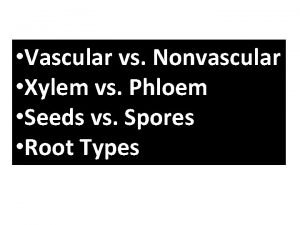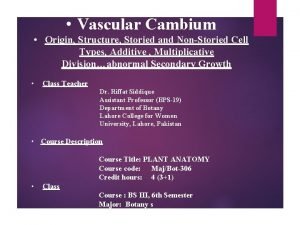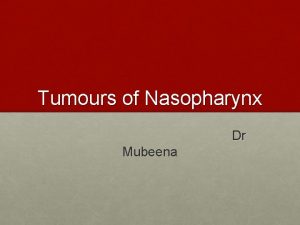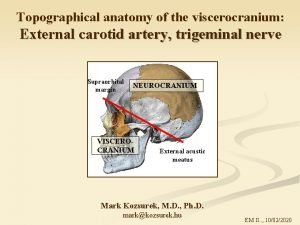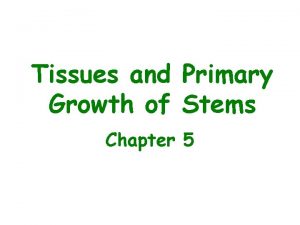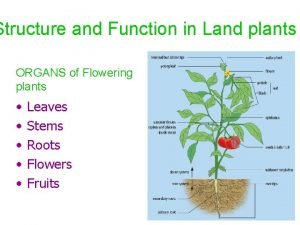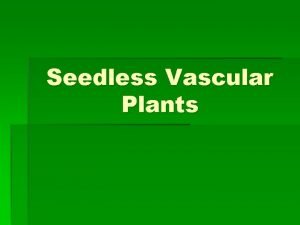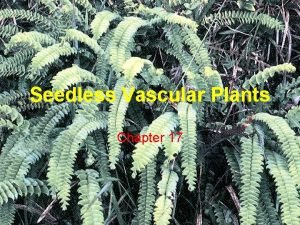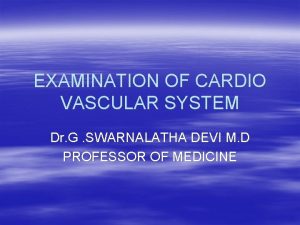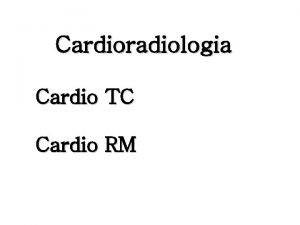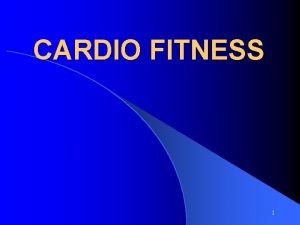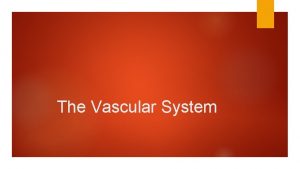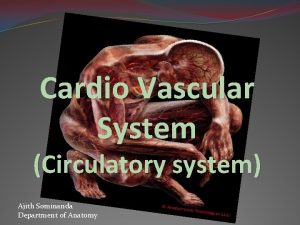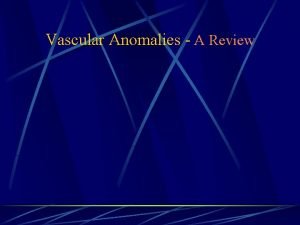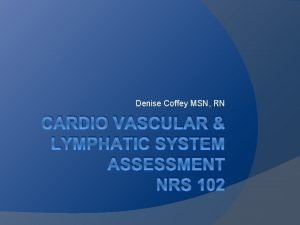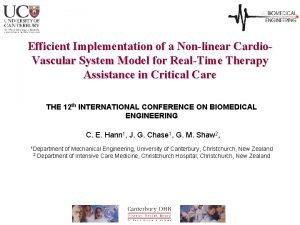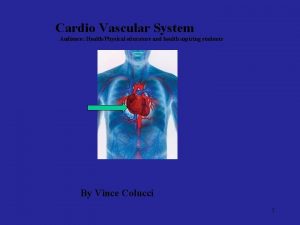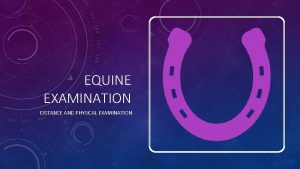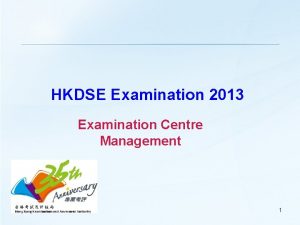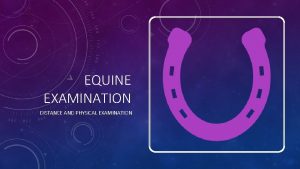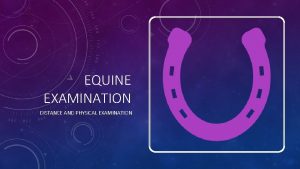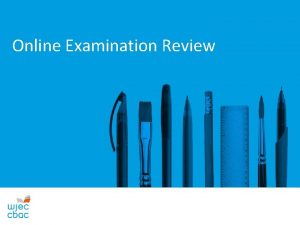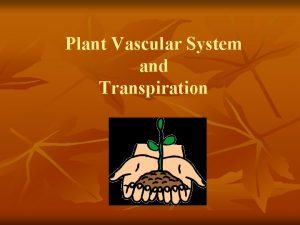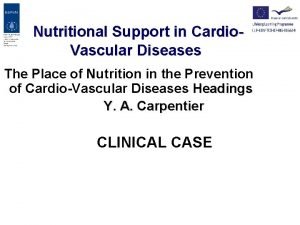EXAMINATION OF CARDIO VASCULAR SYSTEM Dr G SWARNALATHA
















































- Slides: 48

EXAMINATION OF CARDIO VASCULAR SYSTEM Dr. G. SWARNALATHA DEVI M. D PROFESSOR OF MEDICINE

HISTORY § Chest pain—site, radiation, nature, duration of pain, aggravating & releiving factors, associated symptoms § Breathlessness—duration, grade, progression, PND, ORTHOPNEA, § Palpitations, --continuous or intermittent § How they are releived § Syncope—postural , seizures

§ Cough , expectoration, heamoptysis, § Cyanotic spells § Swelling of feet , distension of abdomen, pain abdomen, § Urinary symptoms—oliguria, anuria § Loss of § appetite, loss of weight § Squatting § Stokes-adams attacks

§ Past history-----rheumatic fever, hypertension, diabetes, ischemic heart disease, tuberculosis, drugs, asthma § Personal history—smoking, alcohol, drug addictions, sleep § In female-menstrual history, obstetric history. § Treatment history-rheumatic fever prophylaxis.

GENERAL EXAMINATION § Built, nourishment, pallor, jaundice, cyanosis, clubbing, koilynochia, pedal edema, lymphadenopathy, § Marfanoid features, other congenital anomalies. § High arched palate, low set ears, § Down syndrome features, § poly or syn dactyly, ear lobe crease, § Rheumatic nodules, osler’s janeway nodules § Xanthomas, thyromegaly, § Nicotine stains over fingers

§ VITALS- pulse-Rate, Rhythm-if irregular pulse deficit Volume—high volume or low volume Character— Vessel wall thickening Other peripheral vessels, radio –femoral , radio-radial delay Blood pressure- upper &lower limbs Temparature Respirations –rate, type of breathing

Examination of arterial pulse in clinical medicine

Pulse § The blood forced into aorta during systole not only moves the blood in the vessels forward but also sets up a pressure wave that travels along arteries. The pressure wave expands the arterial wall as it travels , and the expansion is palpable as the pulse.

Normal Pulse

Evaluation § § § § Rate Rhythm Volume Character Vessel wall thickness Radio- femoral delay , radio- radial delay Peripheral pulses Pulse deficit

Rate § § Count the pulse for 1 min / at least 30 sec Normal : 60 – 100 /min Tachycardia : >100 /min Bradycardia : <60 /min

Sinus Tachycardia § Physiological : infants children anxiety , emotion § Pathological : Tachyarrhythmia- SVT, VT High output states § Drugs – atropine nifedipine caffiene, nicotine

High Output States § § § § Anaemia Pyrexia Beri beri Thyrotoxicosis Pheochromocytoma AV fistula cardiogenic shock, cardiac failure Hypovolemia, hypotension

Sinus Bradycardia § Physiological : atheletes, sleep § Pathological : severe hypoxia hypothermia sick sinus syndrome myxoedema obs. jaundice ac. inf wall MI raised ICT § Drugs : beta blockers, verapamil, diltiazem

Relative Bradycardia § § § Typhoid Pt on beta blocker CNS infection with raised ICT

Rhythm § § § Assessed by palpating radial artery Normally – regular Irregular – ectopics Regularly irregular – ventricular bigemini Irregularly irregular – AF, multiple ectopics

Diff b/w heart block & ectopic § Rhythm : § Irregularity changes with exertion – extrasystole / ectopic § Irregularity doesn’t change with exertion – Heart block

Volume § Assessed by palpating – carotid artery § Pulse pressure – accurate measure of pulse volume ( N – 30 – 60 mm Hg ) § Correlates with stroke volume § High volume – high output states anxiety emotional excitability

Volume § Low vol ( pulsus parvus ) – shock myocardial ds Aortic stenosis pericardial ds cardiac failure

Character § Best assessed by palpating – carotid artery § Normal / Abnormal

Vessel Wall Thickness § Assess the state of medium sized arteries which are palpable. § Method: palpate radial artery with middle 3 fingers. Occlude proximally & with index finger empty artery by pressing out blood distally. Applying pressure on either side – roll the artery over underlying bone using middle finger.

Radio – femoral Delay § Usually 2 radial pulses come simultaneously & femoral comes 5 msec before ipsilateral radial pulse. § Delay in femoral pulse – obstruction of aorta – coarctation

Peripheral Pulses Radial pulse § At wrist , lateral to flexor carpi radialis tendon , place your three middle fingers over the radial pulse

Carotid Pulse § Palpate carotid pulse with the pt lying on a bed / couch § Never compress both carotid arteries simultaneously. § Use your left thumb for right carotid pulse & vice versa. § Place tip of thumb b/w larynx & ant. border of sternocleidomastoid.

Brachial pulse § Use your thumb ( rt thumb for rt. arm & vice versa ) with your fingers cupped round the back of the elbow. § Brachial pulse – felt in front of the elbow just medial to tendon of biceps.

Femoral Pulse § Is felt at groin just below inguinal ligament midway b/w ant. sup. iliac. spine & symphysis pubis.

Popliteal pulse § Knee to be flexed 40 deg. Heel resting on bed § Place fingers over lower part of popliteal fossa & fingers are moved sideways to feel pulsation of Popliteal. A against post. aspect of tibial condyles.

Posterior Tibial Pulse § Felt just behind medial malleolus , midway b/w medial malleolus & tendo achillis.

Dorsalis Pedis Pulse § Felt just lateral to tendon of ext. hallucis longus.

Pulse Apex Deficit § Diff b/w heart rate & pulse rate , when counted simultaneously for one minute. § Diff b/w AF & Ectopics Features Pulse deficit On exertion rhythm Atrial fibrillation > 10 / min Persists/increas e Irregularly irregular Ectopics < 10 / min Decrease Regularly irregular

Hypokinetic & Hyperkinetic Pulses § Hypokinetic pulse – small volume, narrow pulse pressure § Eg: cardiac failure, MS, AS, Shock § Hyperkinetic pulse: large volume pulse with high stroke vol, wide pulse pressure § Eg : high output states , MR, VSD

Collapsing Pulse § Corrigan’s pulse / water hammer pulse § Large vol pulse with rapid upstroke ( high sys. pressure ) & rapid downstroke ( low diastolic pressure ) § Rapid upstroke – increased stroke vol § Rapid downstroke – diastolic runoff into Lt. Ven & decreased PR & rapid runoff to periphery. § AR

Pulsus Alternans § Alternating strong & weak pulse. § Palpation of radial, femoral, brachial pulses § Palpation by light pressure, breath held in mid expiration § Better – recording BP, when sys. pressure alternates by >20 mm

Pulsus Alternans § A sign of severe LV dysfunction.

Pulsus Paradoxus § Exaggerated reduction in strength of arterial pulse during normal inspiration due to exaggerated insp fall in sys. pressure (> 10 mm) § >20 mm Hg – detected by palpating brachial artery § Milder fall – measuring BP

Pulsus Paradoxus § Cardiac tamponade, constrictive pericarditis, § severe airway obstruction , § SVC obstruction

Recording Of BP § Pulsus paradoxus : inflate bp cuff to suprasystolic level & deflate slowly @ 2 mm/heart beat. § Note - Peak sys. pressure during expiration § Now deflate more slowly – note pressure when korotkoff sound – audible throughout resp. cycle § If diff > 10 mm Hg - pulsus pardoxus +

Pulsus Tardus § Delayed systolic peak resulting from obstruction of lt. ven. ejection § Fixed LV obstruction – Valvular AS

Pulsus Parvus et Tardus § Small vol pulse with delayed systolic peak § Severe AS

Bisferiens Pulse § 2 systolic peaks , the percussion & tidal waves separated by distinct midsystolic dip. § Detected more rapidly by palpating carotid artery. § AS+AR

Dicrotic Pulse § 2 peaks. § 2 nd peak is in diastole after S 2. § Normally a small wave that follows aortic valve closure ( dicrotic notch ) is exaggerated § Due to very low stroke vol & per. Resistance. § LVF

CARDIO VASCULAR SYSTEM § INSPECTION—JVP , column , waves , change with inspiration and expiration § Hepato JUGULAR REFLUX § TRACHEA § CHEST DEFORMITY § ENGORGED VEINS, § VISIBLE PULSATIONS § PRE CORDIAL BULGE § APEX BEAT

PALPATION § § § § TRACHEAL POSITION APEX BEAT-- POSITION, NATURE, THRILLS, PALPABLE SOUNDS, RUB LEFT PARA STERNAL HEAVE-- GRADE

PERCUSSION § § RIGHT& LEFT BORDERS RETRO STERNAL DULLNESS LIVER DULLNESS LEFT SECOND SPACE

AUSCULTATION § MITRAL , TRICUSPID , AORTIC , PULMONARY AREAS— § HEART SOUNDS- INTENSITY SOFT OR LOUD , CHANGING INTENSITY § 1 , 2 , 3 , 4 SOUNDS § SPLITTING OF SECOND SOUND § OPENING SNAP

AUSCULTATION § MURMURS—SITE § , TIMING, § SELECTIVE CONDUCTION, § QUALITY, § PITCH § , HEARD WITH BELL OR DIAPHRAGM § , EFFECT OF EXERCISE, § CHANGE WITH RESPIRATION § CLICKS § PERICARDIAL RUB

§ § § § § PERIPHERAL SIGNS OF AORTIC REGURGITATIONCOLLAPSING PULSE , HILL’S SIGN , PISTOL SHOT SOUNDS, DUROZIEZ’S MURMUR, ALFRED DEMUSSET’S SIGN, QUINCKY’S SIGN, HEPATIC, SPLENIC PULSATIONS SIGNS OF INFECTIVE ENDOCARDITIS EXAMINATION OF OTHER SYSTEMS

§ THANK YOU
 Vascular plants vs nonvascular plants
Vascular plants vs nonvascular plants Non vascular vs vascular plants
Non vascular vs vascular plants Vascular and non vascular difference
Vascular and non vascular difference Alrtpnc
Alrtpnc Suportul vital bazal la copii
Suportul vital bazal la copii Arii malare
Arii malare Index cardio thoracique
Index cardio thoracique Signe de l'iceberg radio
Signe de l'iceberg radio Lordotic chest x ray
Lordotic chest x ray Cardio vision
Cardio vision Apex poumon
Apex poumon Cauze reversibile de stop cardio-respirator
Cauze reversibile de stop cardio-respirator Injurgitacion yugular
Injurgitacion yugular Nssttc
Nssttc Cardio sense
Cardio sense Calcul index cardio thoracique
Calcul index cardio thoracique Nimia sufijo
Nimia sufijo Signe de cruveilhier baumgarten
Signe de cruveilhier baumgarten Cardiomems video
Cardiomems video Tonus cardio moderateur
Tonus cardio moderateur Cardio soft
Cardio soft Cardio map
Cardio map Investigator photos
Investigator photos Trusight cardio
Trusight cardio 4tech cardio
4tech cardio Discovery cardio care programme
Discovery cardio care programme Digeorge syndrome
Digeorge syndrome Electro cardio gram
Electro cardio gram Atl cardio
Atl cardio Cardio alex
Cardio alex Peripheral vascular system
Peripheral vascular system Vascular system
Vascular system Oral spines starfish
Oral spines starfish Systemic examination of respiratory system
Systemic examination of respiratory system Integumentary system physical examination
Integumentary system physical examination Function of male reproductive system
Function of male reproductive system Examination management system
Examination management system Virtual university examination system
Virtual university examination system Locomotor system examination
Locomotor system examination Nutrient artery
Nutrient artery Vascular vs nonvascular
Vascular vs nonvascular Structure of vascular cambium
Structure of vascular cambium Nonvascular plants
Nonvascular plants Hamartomatous nidus of vascular tissue in nasopharynx
Hamartomatous nidus of vascular tissue in nasopharynx Infraorbital artery
Infraorbital artery Xylem in stem
Xylem in stem Quizlet
Quizlet Seedless vascular plant life cycle
Seedless vascular plant life cycle Vascular plants
Vascular plants

